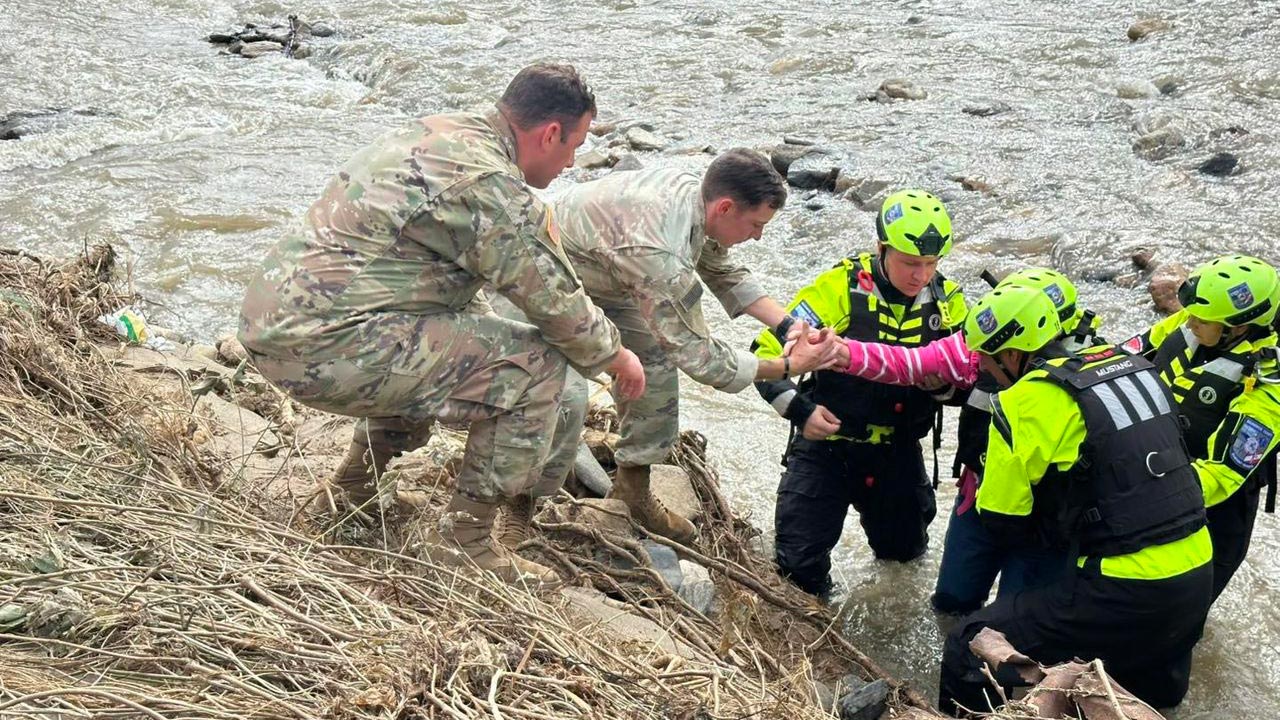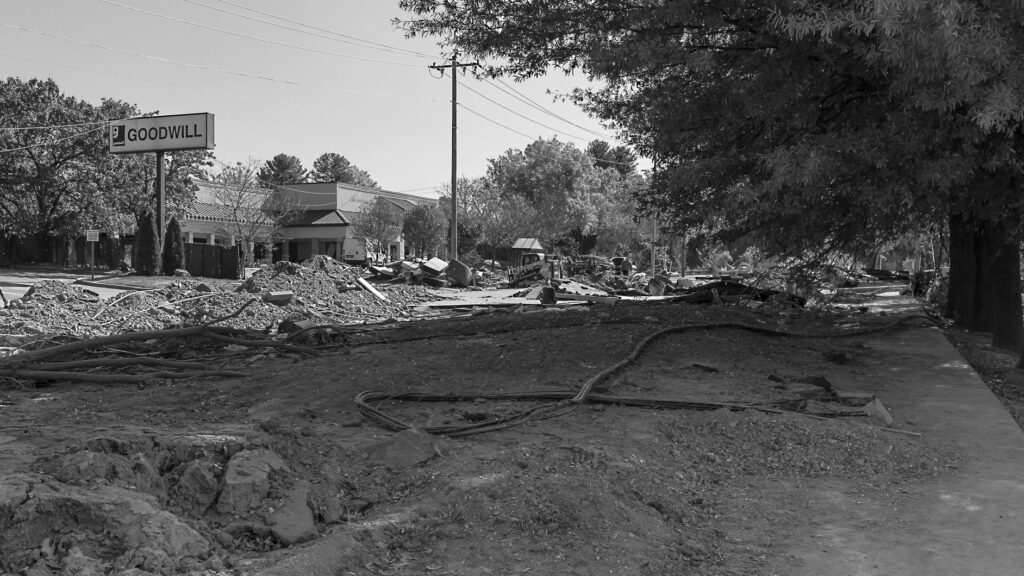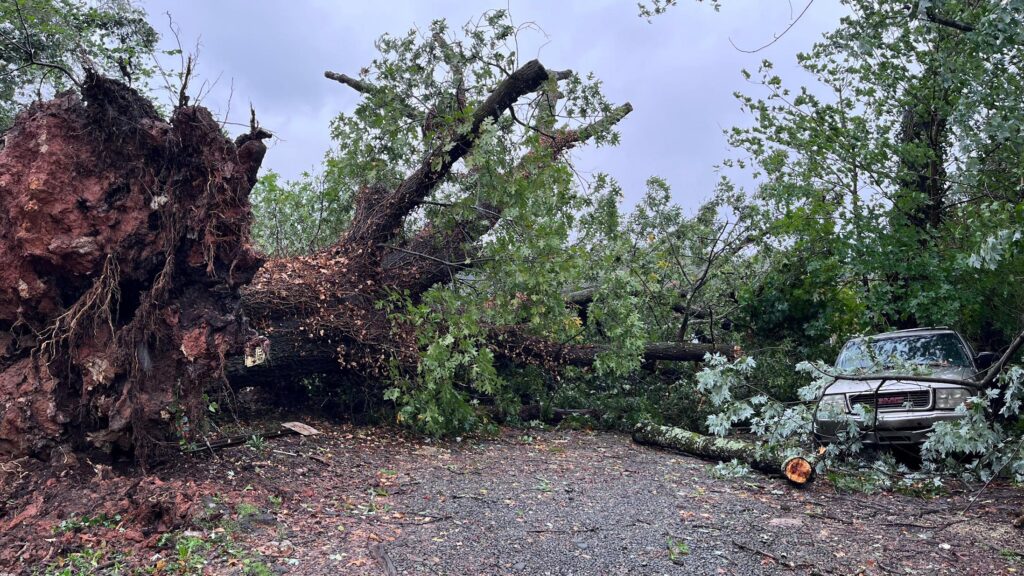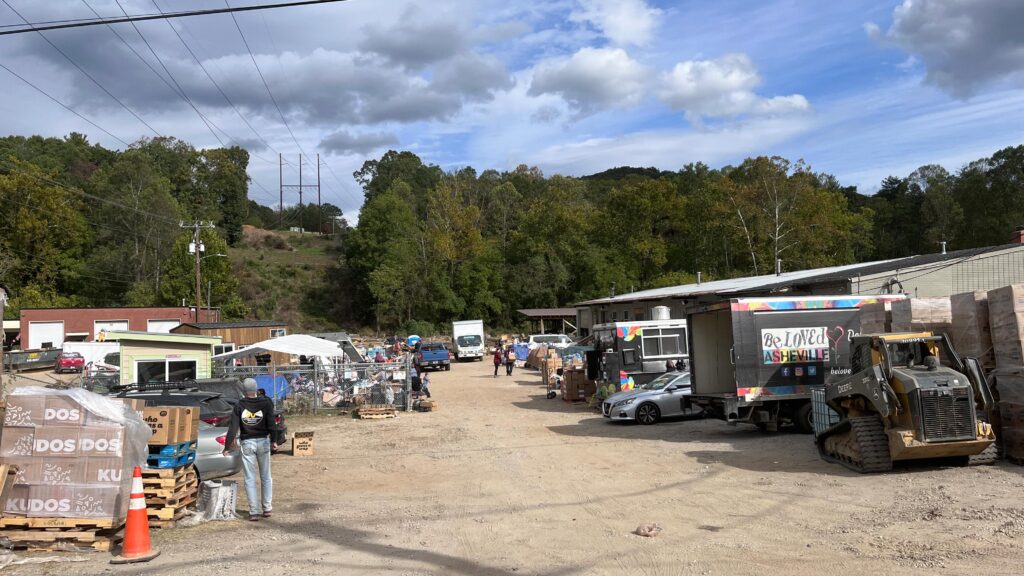
North Carolina National Guard Soldiers help with a swiftwater rescue in Polk County, NC, on September 26, 2024. US Army photo by Sgt. Jordan Hayden.CC BY 2.0.
NCICS staff are safe and have returned to work, but friends, neighbors, and our region experienced devastating impacts.
By Tom Maycock. Edited by Mark Essig and Andrea McCarrick.
The North Carolina Institute for Climate Studies is based in downtown Asheville, North Carolina, where we share a building with NOAA’s National Centers for Environmental Information (NCEI). Asheville sits in a broad river valley surrounded by the mountains of Western North Carolina, including the highest elevations in the eastern United States. October usually brings a stunning display of fall colors and a massive influx of leaf-peeping tourists. This year, things turned out very differently.
In late September, one of the most devastating extreme weather events in US history upended life here in Asheville and across the region. We at NCICS will be experiencing the effects of—and working to understand—Hurricane Helene for months and years to come.
Fortunately, all of our staff are safe, as are all of our colleagues at NCEI. Most of us experienced fairly minimal direct damages, but some are still dealing with significant home or auto damage. Grappling with what has happened to friends, neighbors, and our community will be a long and difficult process. We are all grateful to those who have been working long hours under extreme circumstances to restore power, communications, and water services and to support those in need. At NCICS, we are now back working a regular schedule, although our definitions of normal in every other sense have changed.
The Storm

NCICS’s Mark Essig measured 7.92 inches of rain between the afternoon of Wednesday, September 25th, and the morning of Thursday, September 26th, in north Asheville. Helene delivered another 5.6 inches by Friday afternoon, for a total of almost 14 inches of rain over three days. Photo by Mark Essig.
The rains began in earnest on Wednesday, September 25—an unrelenting stream of precipitation along a front that funneled moisture from the Gulf of Mexico into Western North Carolina. This predecessor rain event brought inches of rainfall to many locations, and by Thursday morning, many rivers and streams had reached minor to moderate flood stages. Some people lost power that morning as trees and power lines fell. Still, this precipitation alone would not have led to devastating outcomes.
But the rain continued later on Thursday, while the hurricane was intensifying rapidly over the Gulf. Helene eventually reached Category 4 strength before making landfall in Florida, and then moved on a collision course with the Blue Ridge Escarpment and the high mountains of the southern Appalachians.
Although Helene weakened to tropical storm force by the time the eye of the storm passed to the west of Asheville, it nonetheless delivered record-setting single-day rainfall totals—as much as a foot of rain in some places, resulting in three-day totals exceeding 30 inches in some areas. The storm’s sustained winds wreaked havoc for hours, with gusts reaching hurricane force at many higher elevations.

Downed trees on the Blue Ridge Parkway near Linville Falls, NC. National Park Service.
Flood heights along major rivers exceeded previous records by as much as 10 feet. Small creeks became raging rivers. More than a thousand landslides and debris flows scarred the landscape and destroyed homes and businesses. At last count, the storm has led to 102 deaths in North Carolina, including 43 in Buncombe County, where Asheville is located. Downed trees and washed-out roads made travel almost impossible across Western North Carolina. Power, cell, and internet service disappeared by Friday morning for almost everyone in the area. These barriers to both access and communications made search, rescue, and relief efforts incredibly challenging.
Meanwhile, faucets for most people in the Asheville area ran dry on Friday as the pipeline and distribution network from the city’s primary reservoir were severely damaged. As of a month later, water flow to most of Asheville has been restored, but the water is not safe to drink as the reservoir has far more sediment than the standard filtration equipment can handle. Fortunately, climate adaptation and earthquake mitigation work on the reservoir’s dam, completed in 2020, may have avoided an even more catastrophic outcome.
The Influence of Climate Change
All weather events now occur against a background climate that has been altered by more than 100 years of human-driven climate change, and this event was no exception. Some of the most direct consequences of greenhouse gas–driven global warming are increases in atmospheric moisture and associated heavy precipitation, as well as increases in ocean temperatures that provide critical fuel for hurricanes. Evidence, including research led by NCICS scientists, shows that these outcomes are already happening. Methods now exist for estimating the influence of climate change on specific weather events, and three early rapid-attribution studies found that climate change likely increased the magnitude and/or likelihood of the devastating impacts of this storm.
Asheville is one of the world’s leading centers for documenting, studying, and communicating about climate change, and some news stories have noted the irony that this center of climate expertise is experiencing the profound effects of a storm fueled by climate change. Sadly, this is an outcome that may have been more inevitable than ironic. In any case, the climate science community here will certainly have much to say about this storm, its impacts, and the extent to which climate change influenced this unprecedented event. That work, however, will take some time.
Inside a Disaster
With power and communications suddenly unavailable or difficult to access, the normal work of NCICS became impossible. Our new priorities included ensuring access to food and water. For some, damage to homes or cars demanded immediate attention and, in some cases, finding a new place to stay.
For those of us lucky enough to avoid significant damage, we were suddenly part of a community working to sustain each other. We helped clear roads of downed trees. We checked on family, friends, colleagues, and neighbors, bringing them food and sometimes flushing their toilets with buckets of water.
We gave clothes to those who had nothing more than what they were wearing. We spent time just listening to those who needed to talk about what they had lost. When routes to the outside world began to open, we made trips to other cities to bring back supplies to friends and strangers.
We helped organizations like World Central Kitchen prepare and deliver meals and drove nearly impassable roads to do wellness checks. We donated time and money to many local organizations, such as BeLoved Asheville and MANNA Foodbank. We shared meals with neighbors and strangers. We even marveled at the beautiful October weather that followed the storm.
Meanwhile, some of us worked tirelessly to help restore internet and computing services for NCICS and NCEI.
Others responded to multiple requests for media interviews, providing informed climate insight into this unprecedented event.

Recovery efforts involved countless hours of incredibly challenging work from the US Army, the National Guard, the Federal Emergency Management Agency, other federal, state, and city agencies, fire departments from around the country, thousands of linemen and other utility-restoration experts from across the US and Canada, dozens of charitable organizations, and individual volunteers. Asheville, NC. October 6, 2024. Photo by https://www.flickr.com/photos/billmcmannis. CC BY 2.0
We watched our skies fill with helicopters from dawn to dusk and saw search and rescue teams arrive from all over the country—rescuing many but sometimes only able to help recover those who were lost. As hot spots of cell or WiFi service opened up, we gradually became aware of the extent of the devastation. We listened to briefings that revealed the severity of damage to the city’s water system, and we wondered what the next days and weeks would bring.
We watched fleets of power trucks fill the roads and even saw helicopters delivering new power poles. We welcomed the donations, assistance, concern, and condolences that poured in from around the country and beyond.
First Steps Down a Long Road
It took a while for food and water to become widely available to those in need, but eventually, churches and community centers and improvised roadside stands and front porches were overflowing with water, canned goods, diapers, baby formula, and other necessities. Some of the most vulnerable or most isolated still face extreme challenges. Many no longer have homes, have limited access to food and water, or are facing weeks or even months before power is restored to their area.
Some parts of Asheville now look relatively unscathed, although growing debris piles along roads make it impossible to forget what happened here. But in many parts of Asheville and across the region, the transition from complete devastation to something different will take much longer. The mountains and forests will bear the scars for many years to come.

South Tunnel Road in Asheville, NC, a month after the storm. October 26, 2024. Photo by https://www.flickr.com/photos/billmcmannis. CC BY 2.0
And as with other weather disasters like Helene, the injuries, illness, and even fatalities don’t stop when the skies clear. A study published just after Helene found that an average tropical cyclone event in the contiguous United States ultimately results in 7,000–11,000 excess deaths over the days, months, and years following the event.
But society did not break down. Instead, people shared anything they could and took only what they needed. Asheville being Asheville, local musicians quickly organized a daily schedule of free outdoor music to bring some joy to those preparing and sharing meals downtown. And there are other things to celebrate.

World Central Kitchen continues to supply meals and potable water to communities in Western North Carolina. It is one of many organizations providing food, supplies, and cleanup and rebuilding assistance in the region. Asheville, NC. October 1, 2024. Photo by Mark Essig.
Returning to Work with New Perspectives
Thanks to some astonishing efforts by workers across multiple infrastructure sectors, we are back at work, appreciative of the patience and grace of our partners and colleagues around the country and across the globe. And NCEI is busy catching up on ingesting and archiving data and reporting on the state of the climate.
But things are and will be different. We knew this storm would be bad—especially those of us with deep expertise in meteorology and tropical storm systems and how mountains can wring extreme rainfall out of those storms. But we still couldn’t quite imagine how bad the outcomes could be. No one alive in this region had seen anything like it. We hope none of us ever will again.
We research the long-term health impacts of disasters, teasing out knowledge from datasets. But it is a different thing to have to explain that every route to a hospital is blocked by downed trees to a mother trying to find help for her son who is having an asthma attack. Or to know that weeks after the storm, sewer systems in some areas are still damaged, leaving untreated sewage flowing into local rivers, threatening the health of those downstream.
We understand the physics and statistics of extreme weather events and how powerful they can be. That understanding did not prepare us to look down on a field of mud where once there were homes, or to smell the gas leaking from pipes that were once connected to houses.
These experiences will change us and the work we do. In the near term, damaged roads and the lack of potable water from our taps make everything a bit more challenging. There will be physical and psychological tolls that play out over time, in different ways. And we carry with us an awareness that we have been much luckier than many.
But the work will continue, informed by this heightened awareness and an even greater sense of urgency. The ongoing recovery efforts will remind us of the critical need to understand how we are affecting our climate and the options we have to minimize and respond to those changes. And even as we work on global- and national-scale questions, we will also strive to help Asheville and Western North Carolina become more resilient in the face of a changing climate.


